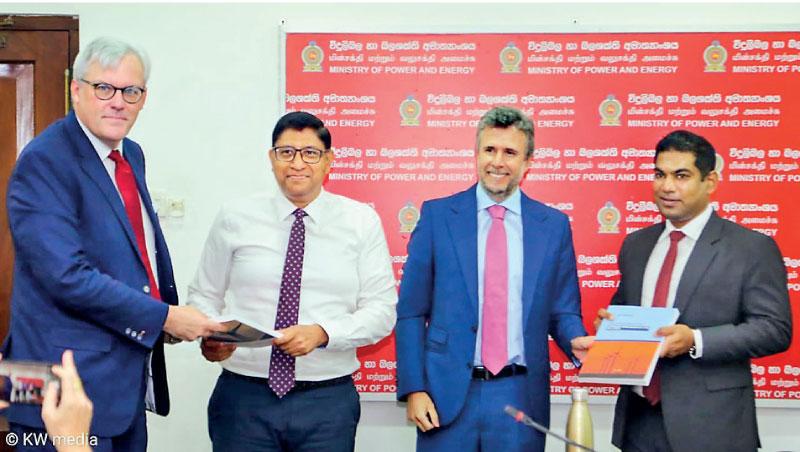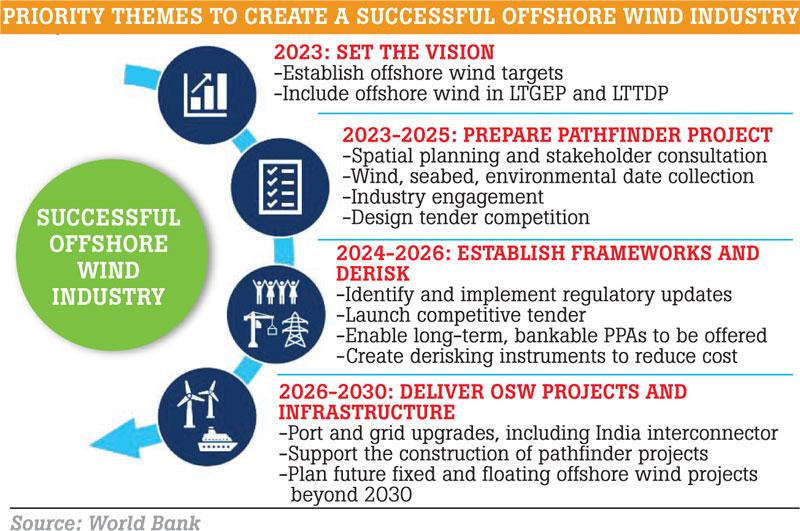26 Aug 2023 - {{hitsCtrl.values.hits}}

Power and Energy Minister Kanchana Wijesekera (extreme right) receives a copy of the ‘Offshore Wind Roadmap for Sri Lanka’ at the launch held on the ministry premises. The roadmap was launched with financial and technical assistance from the World Bank, IFC, ESMAP and PROBLUE

By Shabiya Ali Ahlam
Sri Lanka has a clear opportunity to deploy offshore wind generation, the World Bank (WB) said; however, there are important technical and economic challenges and risks that can make the opportunity less attractive to investors and project developers.
The overall market opportunity is relatively small, which could make it more difficult to attract capable and experienced project developers to Sri Lanka, the WB highlighted in its ‘Offshore Wind Roadmap for Sri Lanka’, which was unveiled on Thursday.
As developers are likely to include a premium to cover the risks and limited opportunity and this would increase the cost of electricity, derisking the investments to the extent possible is therefore critical.
“For these reasons, it is recommended that the government takes a proactive role in the planning and delivery of offshore wind projects. It should do this by carrying out early-stage development activities and providing greater regulatory and commercial certainty,” the WB recommended.
Doing so will reduce the risk to investors, making the opportunity more attractive and help to reduce costs. It will also provide time for the country’s economy to recover before inviting investors to enter Sri Lanka.
Further derisking instruments, including guarantees, would likely be required to attract the required capital at an affordable rate, the WB added.
Given that the development of offshore wind projects takes considerably longer time than for onshore renewable energy projects, to avoid delays and higher costs, the WB stressed it is also essential to focus on quality and risk reduction, to ensure that the data and development work can be relied upon by the developers bidding into the future tender.
To establish a successful offshore wind industry, Sri Lanka, by 2023, must set the vision by selecting offshore wind targets, which include offshore wind in LTGEP LTTDP.
By 2025, the pathfinder project preparation must reach completion, which includes spatial planning and stakeholder consultation, wind, seabed, environmental data collection, industry engagement and designing of tender competition.
From 2024-2026, efforts must be directed towards establishing frameworks and derisk. As per the suggestion of the WB,
this should be done by identifying and implementing regulatory updates, launching competitive tenders, enabling long-term bankable PPAs to be offered and creating derisking instruments to reduce cost.
Finally from 2026-2030, Sri Lanka should deliver OSW projects and infrastructure – port and grid upgrades, including India interconnector, support the construction of pathfinder projects and plan future fixed and floating offshore wind projects beyond 2030.
Sri Lanka has made significant efforts in developing green and renewable energy in recent years, with a notable capacity addition in onshore wind, comprising inter alia the 100MW Mannar Onshore Wind Farm. However, with the ambitious target of obtaining 70 percent of electricity generation via renewable energy sources by 2030 and a full 100 percent renewable energy generation by 2050, offshore wind becomes a relevant and important technology to consider developing.
23 Nov 2024 13 minute ago
23 Nov 2024 20 minute ago
23 Nov 2024 1 hours ago
23 Nov 2024 2 hours ago
23 Nov 2024 3 hours ago